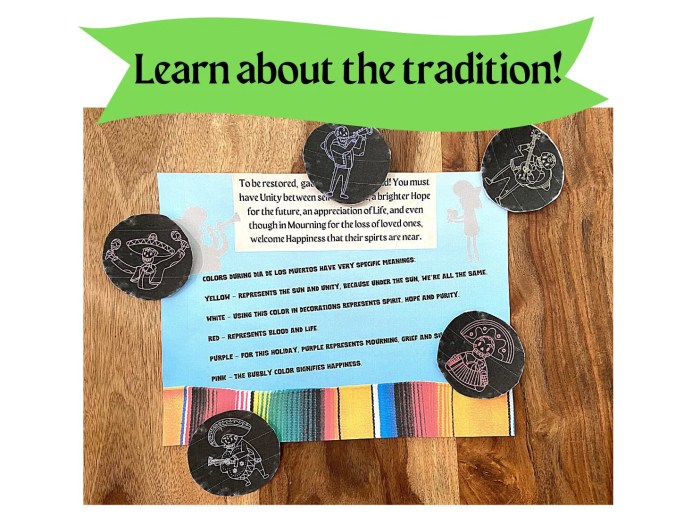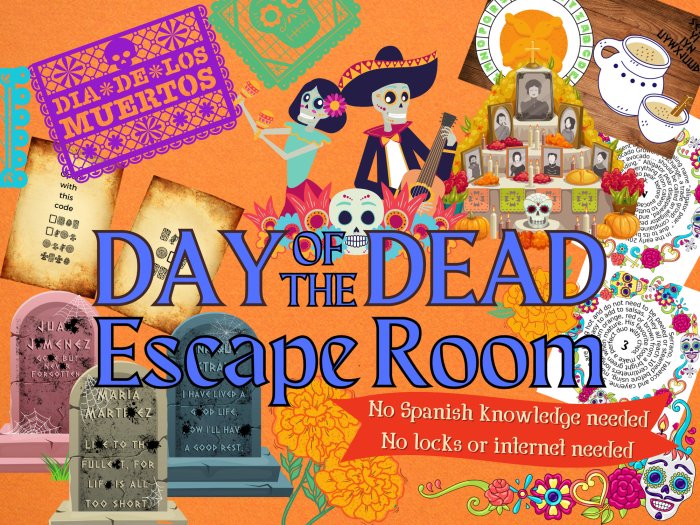Dia de los muertos break out room answers – Dia de los Muertos Breakout Room Answers offers an immersive journey into the captivating traditions and symbolism of the Mexican holiday. This guide provides a comprehensive understanding of the cultural significance, artistic expressions, and social impact of Dia de los Muertos, unlocking the secrets of this vibrant celebration.
From the origins and beliefs associated with the holiday to the intricate symbolism of sugar skulls and marigolds, this guide explores the multifaceted nature of Dia de los Muertos. It delves into the traditional crafts and techniques used to create altars and decorations, showcasing the artistic brilliance of this Mexican tradition.
Cultural Significance of Dia de los Muertos: Dia De Los Muertos Break Out Room Answers

Dia de los Muertos, also known as the Day of the Dead, is a vibrant and deeply rooted Mexican holiday that celebrates the lives of deceased loved ones. Its origins can be traced back to ancient Mesoamerican cultures, where it was believed that the dead could return to the living world during a specific time of the year.
Over time, the holiday has evolved to incorporate Christian elements, resulting in a unique blend of indigenous and Catholic traditions.
Beliefs and Traditions, Dia de los muertos break out room answers
- On Dia de los Muertos, it is believed that the veil between the living and the dead becomes thin, allowing spirits to cross over and visit their families.
- Families prepare elaborate altars, or ofrendas, adorned with food, drinks, flowers, and other items that the deceased enjoyed in life.
- The altars serve as a way to honor the memory of the departed and provide them with nourishment and comfort on their journey.
- Families also visit cemeteries to clean and decorate the graves of their loved ones, bringing flowers, candles, and food.
Regional Celebrations
- Mexico City:Known for its massive parades and lively street parties featuring colorful costumes, music, and dance.
- Oaxaca:Celebrated with elaborate altars, traditional food, and the calenda, a procession of costumed dancers.
- Michoacán:Known for its unique Noche de Muertos, where families camp overnight at cemeteries to honor their departed.
Symbolism and Imagery

Dia de los Muertos is characterized by a rich symbolism that reflects the themes of death, remembrance, and celebration.
Iconic Symbols
- Sugar Skulls:Sweet and colorful skulls made of sugar, representing the deceased and symbolizing the acceptance of death.
- Marigolds:Bright orange flowers believed to guide the spirits of the dead back to their families.
- Altars:Elaborate displays that honor the deceased and provide them with offerings.
Colors and Patterns
- Orange and purple:Associated with death and mourning.
- White:Symbolizes purity and the remembrance of the deceased.
- Floral patterns:Represent the beauty and fragility of life.
Artistic Expressions

Dia de los Muertos inspires a wide range of artistic expressions that commemorate and celebrate the holiday.
Traditional Crafts
- Altar Making:The creation of elaborate altars adorned with marigolds, sugar skulls, and other offerings.
- Sugar Skull Making:The crafting of intricate and colorful sugar skulls that depict the deceased.
- Paper Cutouts:Vibrant and detailed paper cutouts used to decorate altars and homes.
Contemporary Art
- Paintings and Murals:Depictions of Dia de los Muertos scenes, symbols, and themes.
- Sculptures:Three-dimensional representations of sugar skulls, skeletons, and other iconic symbols.
- Photography:Capturing the beauty, traditions, and emotions associated with Dia de los Muertos.
Social and Cultural Impact
Dia de los Muertos plays a significant role in Mexican society and culture.
Community Bonds
- The holiday brings families and communities together to remember and honor their deceased loved ones.
- It strengthens intergenerational bonds and fosters a sense of collective identity.
Cultural Identity
- Dia de los Muertos is a symbol of Mexican cultural heritage and a source of national pride.
- It promotes cultural diversity and understanding by showcasing the unique traditions and beliefs of Mexico.
Educational Value

Dia de los Muertos can be used as a valuable educational tool to teach about Mexican culture, history, and art.
Cultural Understanding
- By exploring the beliefs, traditions, and symbolism of Dia de los Muertos, students can gain a deeper understanding of Mexican culture.
- It can help break down stereotypes and promote cultural appreciation.
Art and History
- The artistic expressions associated with Dia de los Muertos provide a window into Mexican art history and techniques.
- Students can learn about the evolution of traditional crafts and the incorporation of Dia de los Muertos themes into contemporary art.
Essential Questionnaire
What is the significance of sugar skulls in Dia de los Muertos?
Sugar skulls, known as “calaveras de azúcar,” are a traditional symbol of Dia de los Muertos. They represent the deceased and are often decorated with colorful designs and inscriptions, honoring and celebrating the lives of loved ones who have passed away.
How is Dia de los Muertos celebrated in different regions of Mexico?
Dia de los Muertos is celebrated throughout Mexico, but regional variations exist. In some regions, it is a more somber occasion focused on remembrance, while in others, it is a more festive celebration with music, dancing, and colorful decorations.
What are the traditional crafts and techniques involved in creating Dia de los Muertos decorations?
Traditional Dia de los Muertos decorations involve intricate crafts and techniques. Papier-mâché figures, painted ceramics, and hand-woven textiles are commonly used to create altars, sugar skulls, and other festive adornments.